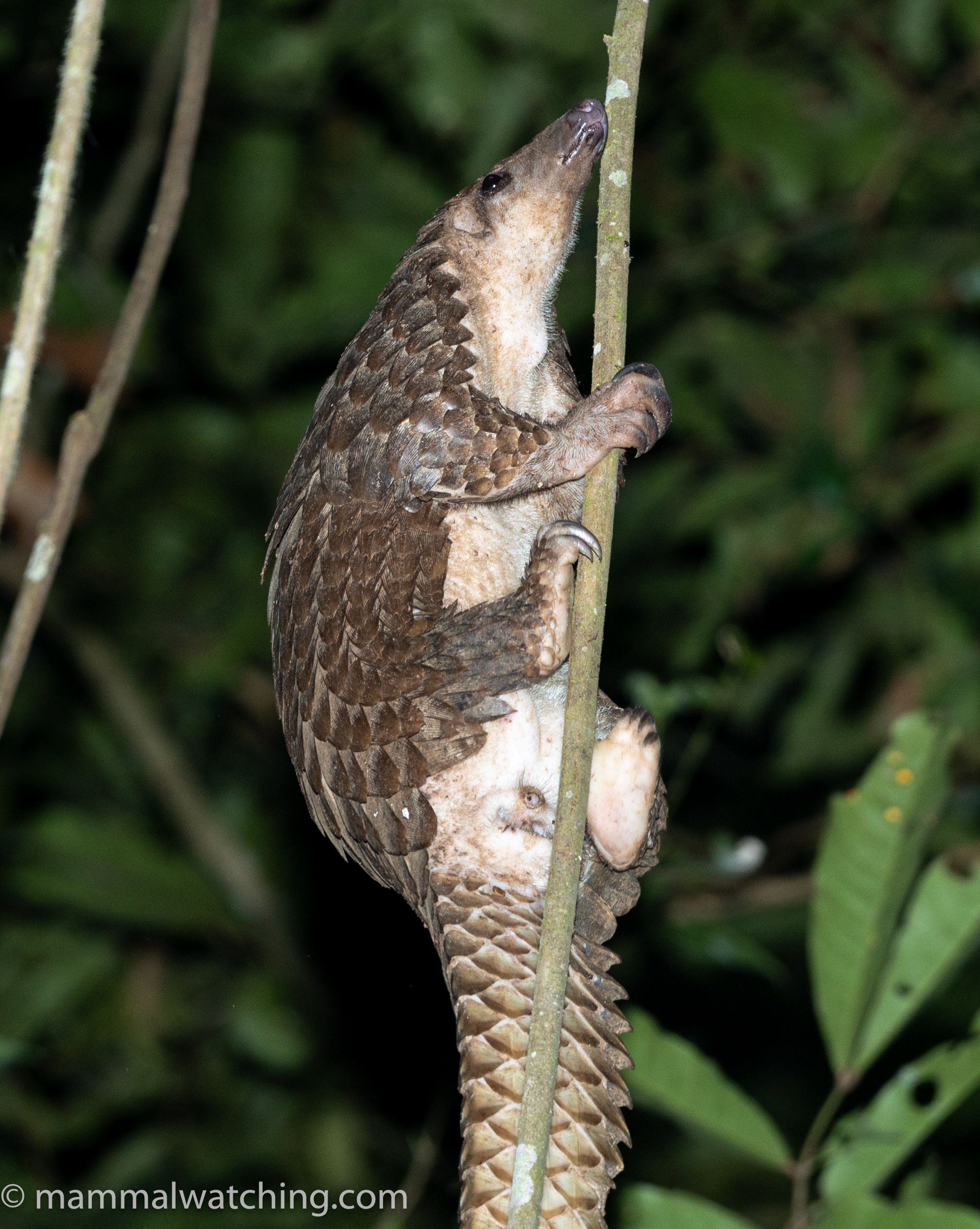
Tai National Park, Côte d’Ivoire, 2024
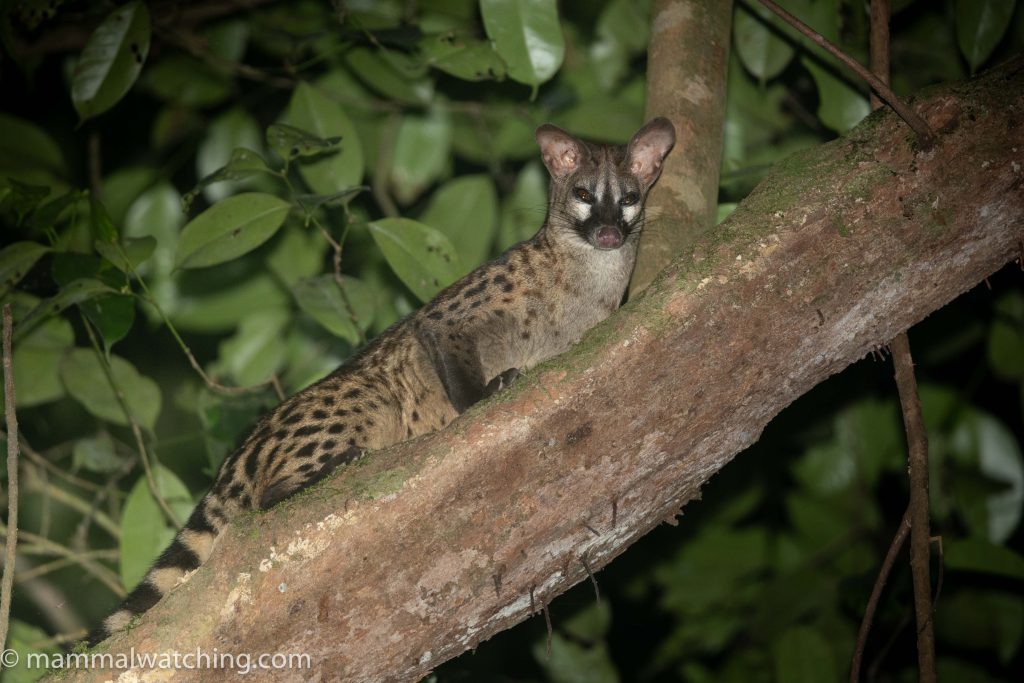
Johnston’s Genet (Genetta johnstoni)
Tai National Park is some of the best remaining rainforest in West Africa. Over the last few years it has become a top tier mammalwatching destination with regular trips from Pictus Safaris and Royle Safaris. Charles Foley and I were keen to visit and visit quickly. Tai seems in good shape right now but there are, unfortunately, never any guarantees about what the future might bring. We spent a week here at the end of February 2024.
Organisation
We organised the trip direct through Tai Forest Lodges. I would like to have met Karl Diakite, the Ivorian ecotourism entrepreneur behind the company, but we just missed him. He speaks and writes in perfect English and was very helpful and is best reached on Whatsapp +225 0788 760000. Karl has a team in San Pedro who were great in organising the details and answering our many questions. You can email them here. I am generally reluctant to talk in detail about the cost of trips like this because prices can change dramatically so you are better off checking direct with Karl. … but the rate at the moment is about $350 a day per person for the camp, which includes everything: food (and beer! if only I had known before we askedfor the bill…) , park fees and Kevin Hino, our fabulous guide. While the price seemed quite high before we got there, we both realised it was good value for money by the end of the trip. If you prefer to have someone organise the trip for you then Tom Clode at Pictus can help.
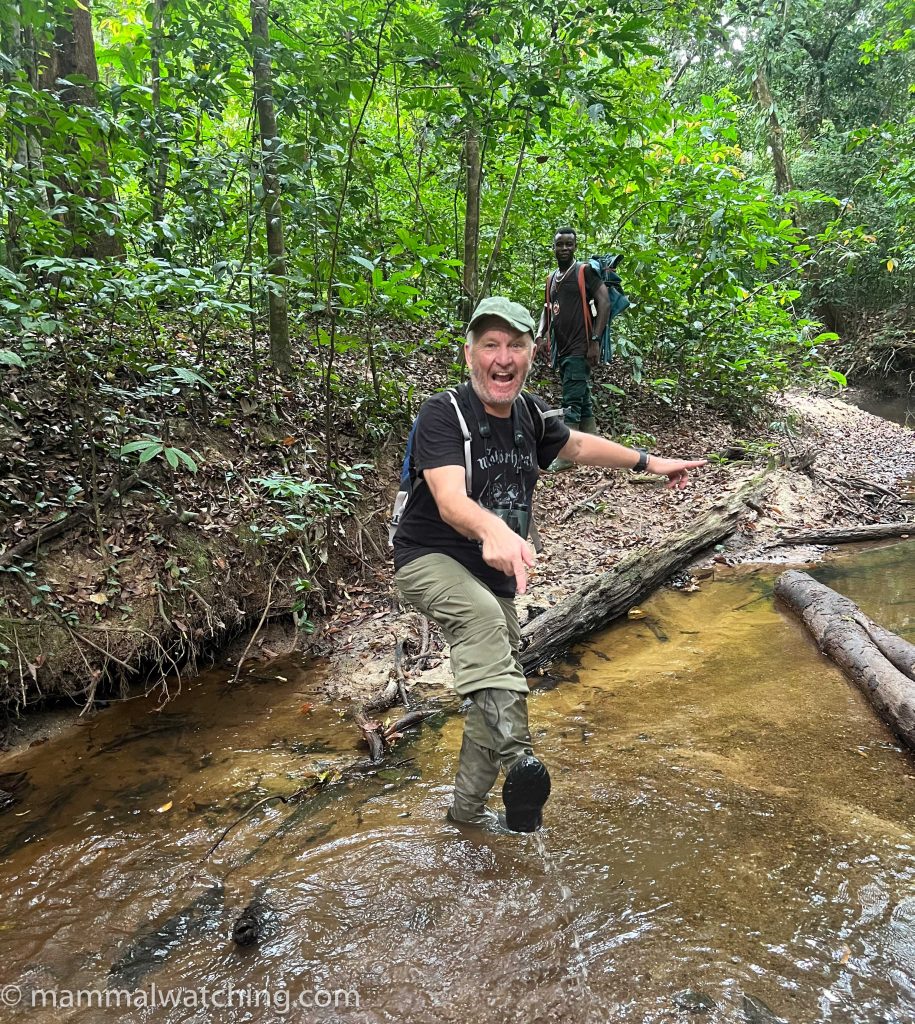
Kevin was not as impressed with my folding wellies as I was
The dry season – January through April – seems the best time of year to visit. Kevin felt that the crossover between the dry and wet season – late April and May – might be better for some species including duikers (something Ben Schweinhart’s excellent report mentions too). It rained only once during our stay: not for very long and in the middle of the night. For the first few nights in the forest the temperatures were more pleasant than I’d expected. I was still scarred from the heat and humidity of Sierra Leone’s Gola Forest in 2017. I made the mistake of telling Charles how pleasantly surprised I was and the temperature rose 4C and the humidity doubled for the rest of the week. Still not as bad as Sierra Leone though. And we had only one night when the temperature made sleeping truly uncomfortable.
We were very lucky to have Kevin Hino as our guide for the whole week, He is the same guide that both Ben Schweinhart and Justin Brown complemented and he was indeed excellent. A super nice guy (as was just about everyone we met in the country), very keen and committed, totally reliable and also a superb naturalist. More on Kevin later. But I don’t think you can do any better, so ask for him! He speaks some English. His English is almost certainly better than our French. Yet somehow Charles and I decided we would converse in ‘French’ with him. In truth we spoke a garbled mix of English, French and a bit of Spanish. Charles kept Kevin on his toes by slipping often into Swahili. I have little idea what we actually said most of the time but it seemed to work and Kevin never stopped smiling. But there was plenty of scope for misunderstanding so when I report later on what Kevin ‘said’ … well, you have been warned…
In Abidjan we stayed at the excellent Blawa Guest House, as recommended by Ian Thompson and others (contact the manager Jose there on WhatsApp +225 0749 310 975). They could not have been more helpful, picking us up from the airport, organizing an especially early breakfast and changing thousands of dollar in Central African Francs for us. US dollars are not as widely accepted as Euros in Ivory Coast and, for dollars, banks might give you a hard time if you try to use smaller denomination notes or older bills. Clean crisp $100s are the way to go.
Getting there and away.
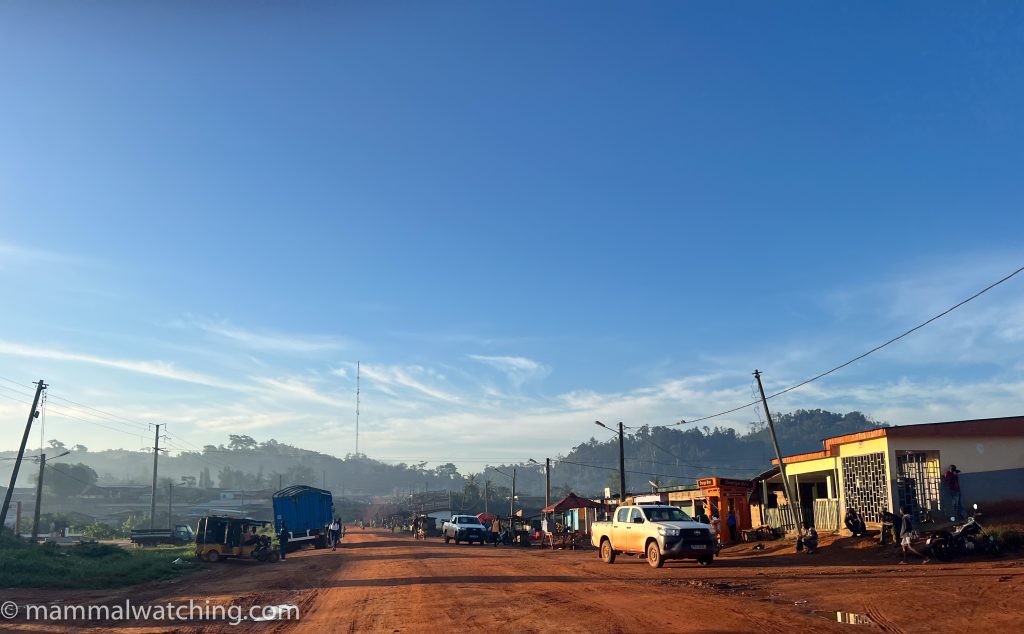
Western Cote D’Ivoire
I flew to Abidjan from Paris on Air France. Charles came in from Nairobi on Air Kenya. Both our flights were several hours late. This seems to be the norm for Air Kenya.
We got visas on arrival. They were very easy to apply for here and approval came through in under 48 hours. You have to collect your visa at the airport which can take a while depending on how many flights just arrived. I queued for an hour. Charles didn’t queue at all.
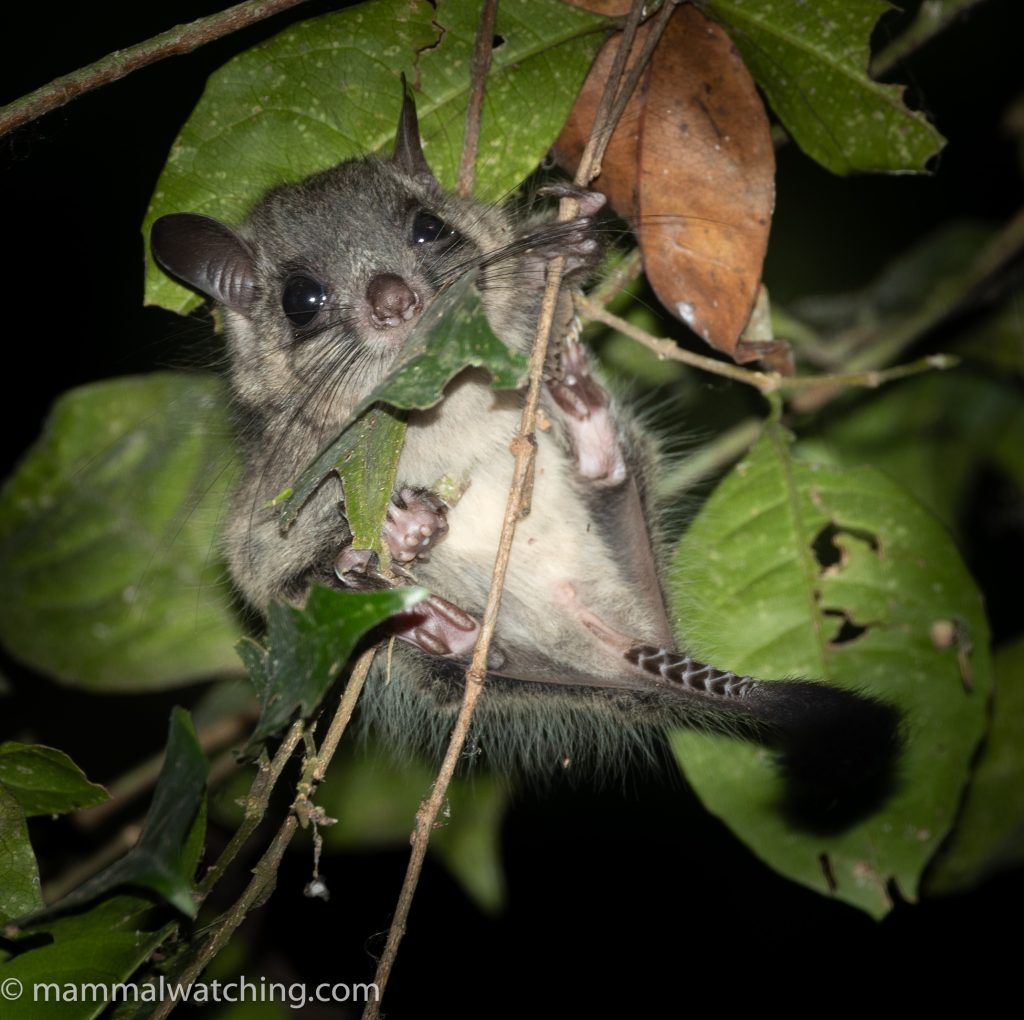
Lesser Anomalure (Anomalurus pusillus)
Tai National Park is in the far southwest of the country, close to the Liberian border. Most of the other mammalwatching trips to Camp Chimpanzee travelled via a domestic flight from Abidjan to the coastal town of San Pedro on Air Cote d’Ivoire, followed by a 5 – 8 hour drive to Ecotel Touraco on the banks of the Tana River just outside the village of Djouroutou. We planned to follow this itinerary until we realised that the daily flight schedules were not in our favour. The flights left Abidjan in the late afternoon. And, as we would both arrive in the evening, we would effectively lose a day waiting for the plane. San Pedro is only 330km from Abidjan and after some discussion with Karl we decided to drive instead. This was a good decision. The road was excellent (perhaps it had been fixed for that month’s African Cup of Nations) and it took less than 4 hours to reach San Pedro, which is not very much longer than the flight would have taken if you factor in time for checking in, waiting for luggage etc. We had tickets to fly back from San Pedro to Abidjan for our return journey but Tom Clode from Pictus had warned me that the flights were prone to frequent schedule changes. Sure enough as we pulled into San Pedro on our return journey I checked the Air Cote D’Ivoire website and saw our flight schedule had changed: the plane was now departing 3 hours later than when we bought the ticket. The airline had not sent a message about the change so if you are flying don’t expect to get a notification.
As any further delay in the flight would mean we might miss out international connections we opted to drive back from San Pedro. It took Karl about 30 minutes to set that up for us. The drive back was slower because of traffic jams in Abidjan and took five and half hours. The airline promised me a refund which came through two weeks later.
The drive between San Pedro and Tai was also quicker than expected: just 5 hours. A very bumpy 5 hours. Our driver had a lead foot and nerves of steel. He said quite a lot to us in a voice so deep that the windows vibrated. I have no idea what he said but most of it felt quite positive: he seemed to be enjoying the drive and his spirited interactions with the gendarmerie.
Tai National park
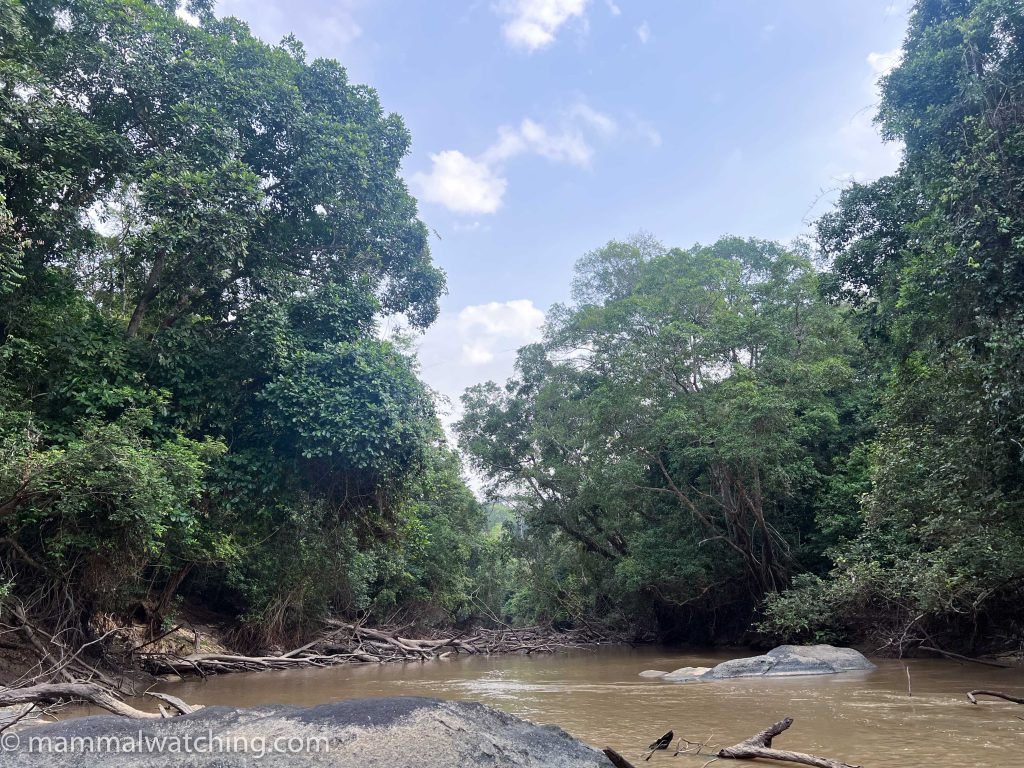
I will list all our mammal encounters later. First a bit of detail about the two places we stayed.
Ecotel Touraco
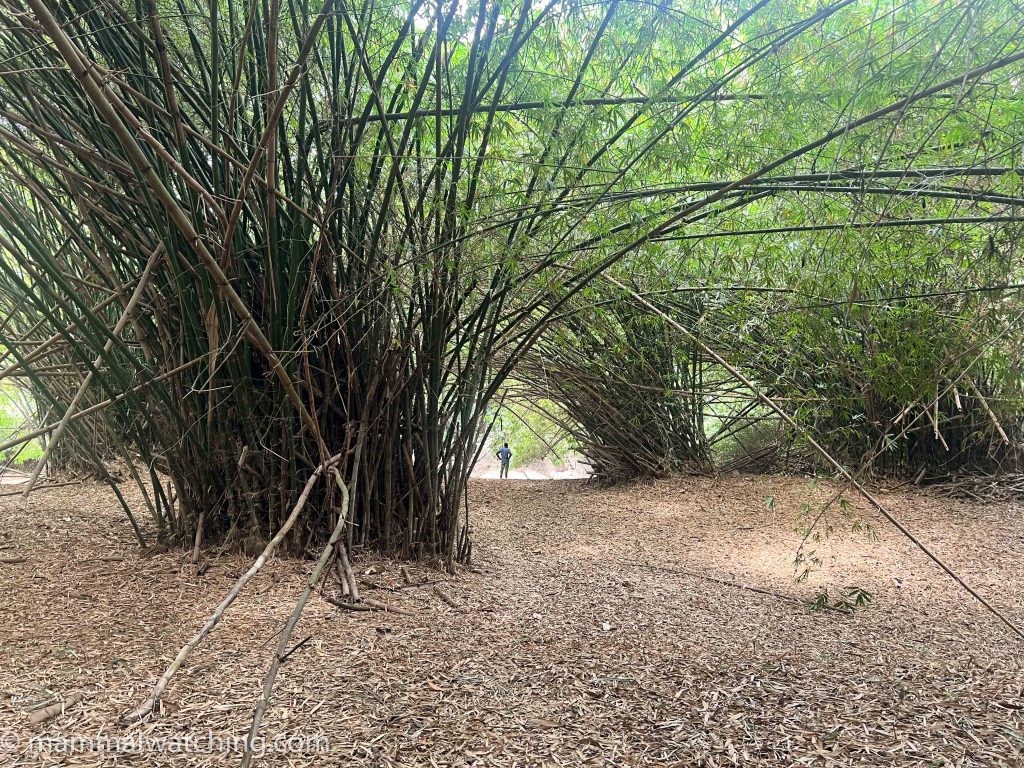
Potto habitat at Ecotel Touraco
We spent the first and last night of our trip at Ecotel Touraco. A comfortable camp with chalets and a restaurant overlooking the forest. Cross the river next to the lodge and you are in the national park. There are plenty of mammals quite close to the hotel: we saw Lesser Spot-nosed and King Colobus Monkeys from the dining area along with what was likely a Bushbuck next to the lodge. We spent our first night here and took the (noisy) boat along the river. Highlights were our only Water Chevrotain and a Brooke’s Duiker. We spent our last night here walking for a couple of hours inside the park and saw a few species including the only pottos of the trip in the stands of bamboo in front of the lodge.
Though the mammalwatching seems considerably better deeper into the park around Camp Chimpanzee, the Ecotel appears to be the base for Pygmy Hippo searching. This seems best done by boat and the Ecotel is next to the river whereas Camp Chimpanzee is a 45 minute walk from it. We travelled by boat to and from the ecotel to Camp Chimpanzee and saw a lot of fresh sign of the hippos: Kevin was pointing out their tracks and slides along the river bank every few minutes. He also pointed to the spots where Justin saw Pygmy Hippos, some of which were surprisingly close to the ecotel. Their technique of using a boat with an electric motor to patrol the river through the night and stop to stakeour hippo spots seems to be effective.
Ian Thompson lucked out and saw a pair of Zebra Duiker as he was walking from the Ecotel to Camp Chimpanzee and Ben Schweinhart saw a Black Duiker along the same trail. We did not.
Camp Chimpanzee
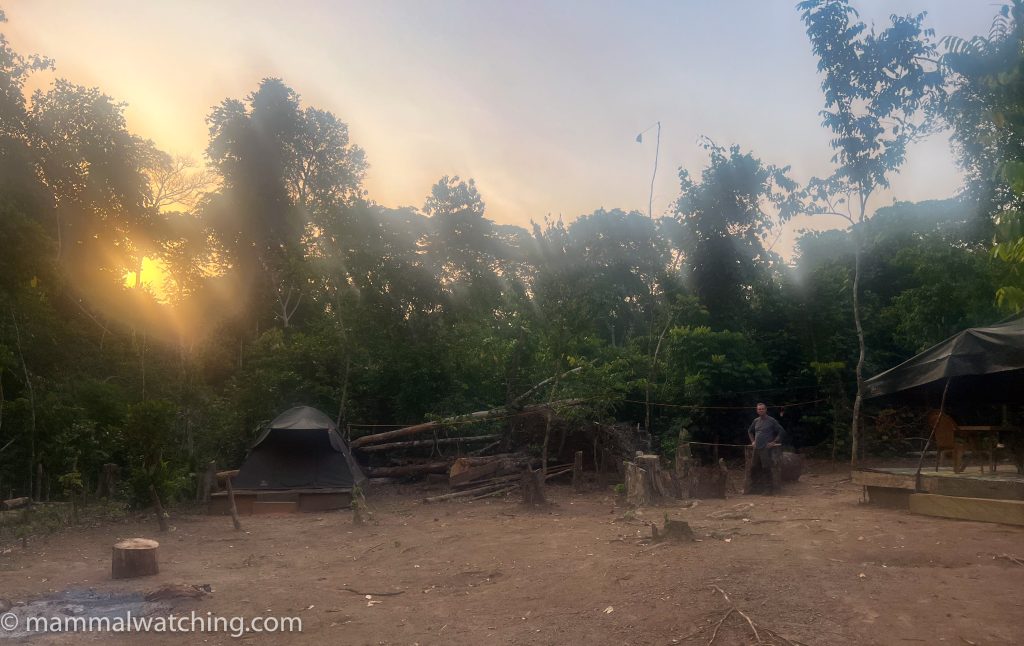
Camp Chimpanzee
Camp Chimpanzee is an 8km walk from Ecotel Touraco or a boat ride and a 45 minute walk. Because the river was so low in February the boat ride was slow: we kept bottoming out on logs which even Kevin’s skills as a boatman could not avoid. There was plenty of sign of Pygmy Hippo and Elephant along the river.
The camp itself comprises a few canvas safari tents with proper beds inside. There is some electricity and a charging station in the staff camping area is available day and night for phones and batteries. There is not a great deal of shade and the tents got unpleasantly hot during the day. I bought a hammock with me which was better for an afternoon siesta. At least until the weather warmed up and the sweat bees emerged. The camp staff were lovely and the food was better than I had expected …light years ahead of Sierra Leone!
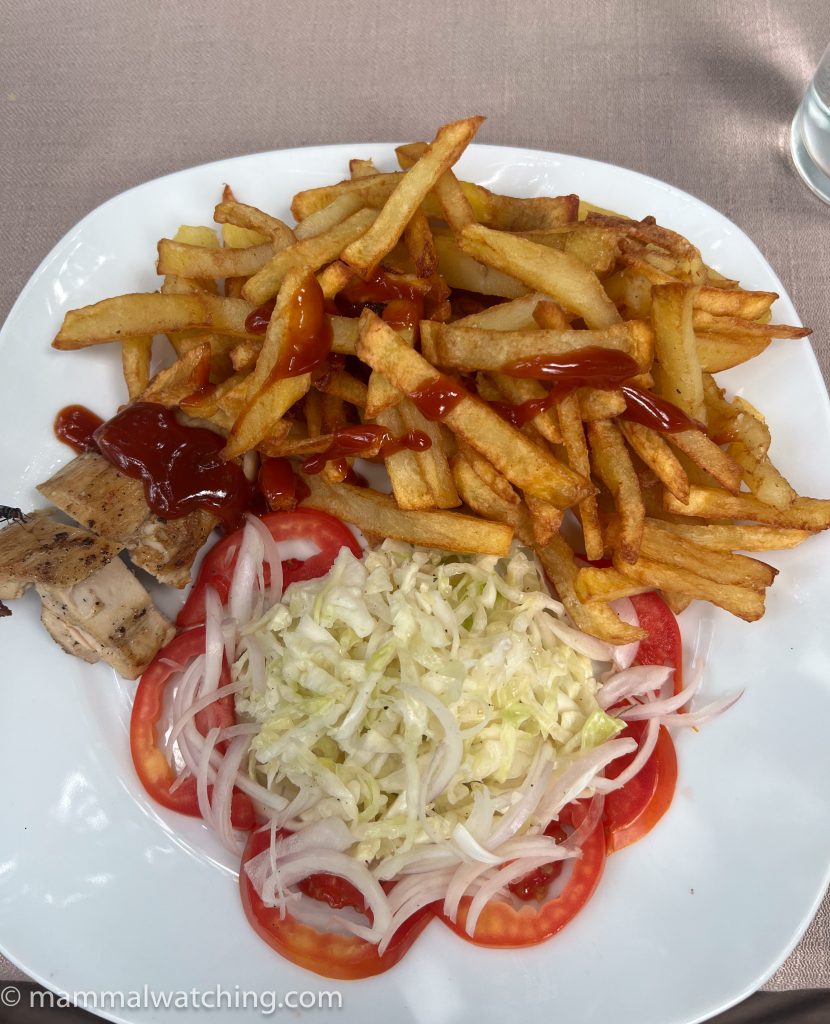
Chicken and chips
The Max Plank Institute runs a chimp research camp here too. One researcher there was happy to show us her camera trap images which proved very helpful for our duiker plans. Different researchers work on different projects and they do not always camera trap. Nor, I imagine, are they all as happy to help as Marije was. But over the past few months she had recorded many exciting species including Bongos, Pygmy Hippos, Jentink’s and Zebra Duikers. I am hoping we might be able to make a short montage of some of the images when she gets back to Europe.
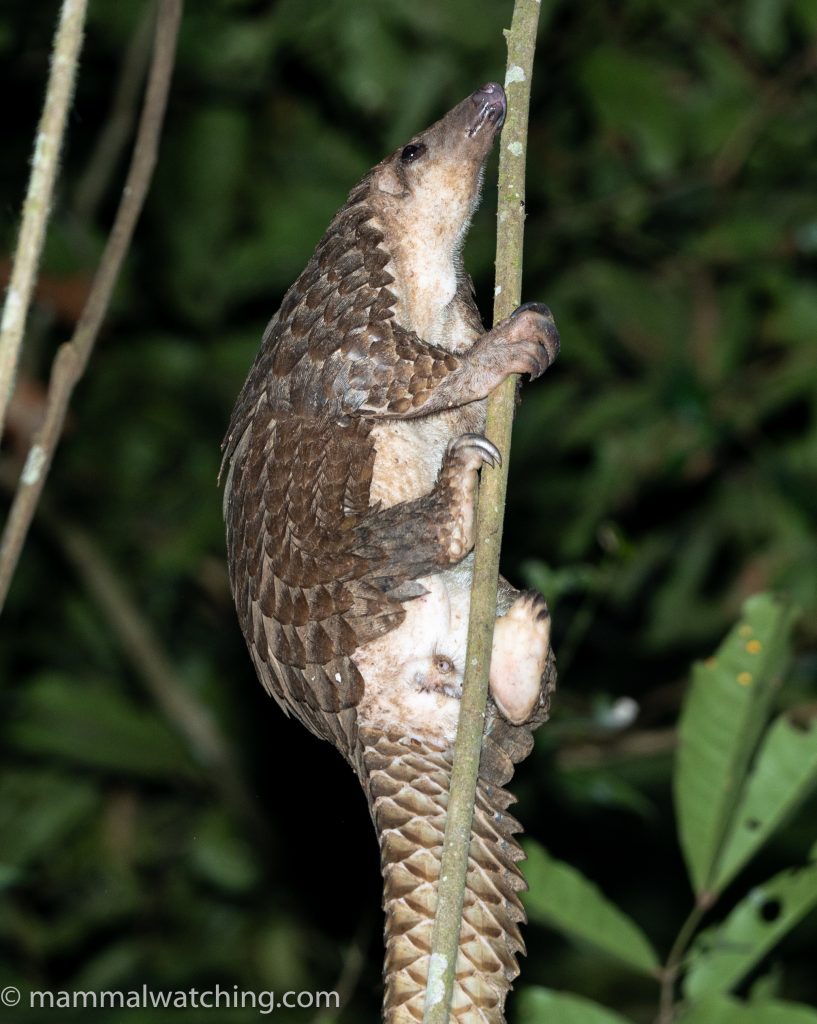
Common African Pangolin (Phataginus tricuspis)
We spent 6 nights at the camp. Unlike most of the mammalwatchers who came before us we did not spend any time looking for Pygmy Hippo (we had seen one in Gola Forest in Sierra Leone), nor did we worry about trying to get good views of the many primates here, all of which we had seen very well on Tiwai Island in Sierra Leone. And we did not spend much time investigating potential bat roosts of which there were many. Instead, our mammalwatching was focused on looking for the two mega duikers here: Zebra and Jentink’s, as well as trying for species like anomalures and pangolins at night. Our strategy evolved over time from walking the trails to walking to duiker hotspots where we would sit on a stakeout for several hours. More on the duikers below. But, in general, the days were quiet other than for primates. And during the few nights we were there we saw much more activity during the first couple of hours after dusk than the 2030 – 2230 period after dinner. After 2300 the mammal activity improved a little though I don’t think we stayed out much later than 0100 on any night.
I was mainly using my new Infrared thermal scope and I let Kevin use my old Pulsar scope, which he used very well.
Details on the species we saw and some information on those we missed are below, though bear in mind that this list, and the photos, reflect our efforts to see our target species. For example, the forest has good primate diversity and we never seemed to be far from a troop of monkeys. Yet we made no effort to photograph them. The monkeys were neither shy nor habituated. But as is often the case, taking decent photos in the rainforest was challenging. If you want to photograph West African primates then Tiwai Island in Sierra Leone has more potential. But there is a greater diversity of mammals overall in Tai.
Seeing Duikers in Tai: An Evolving Strategy
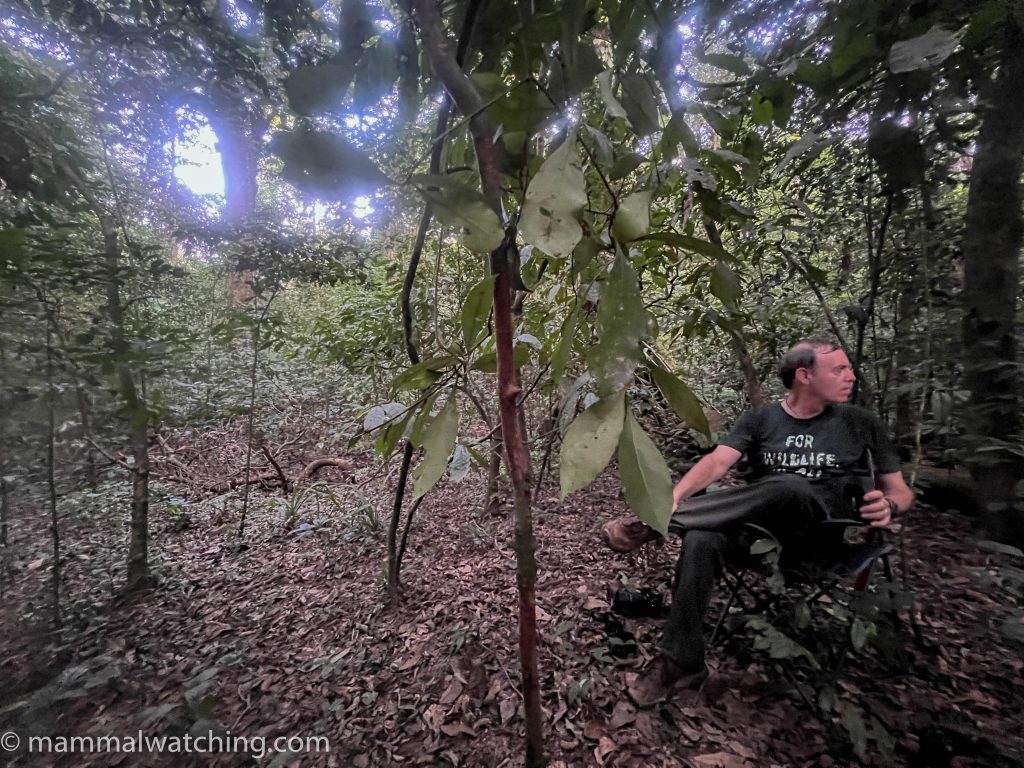
Tai is home to seven species of duiker: Maxwell’s; Brooke’s; Bay; Black; Zebra; Jentink’s and Yellow-backed. Maxwell’s are quite common (we must have seen 10) but the others are harder to find. We saw two Brooke’s Duikers and Kevin saw a Zebra Duiker while we were there. The animals are also shy and apparently still being hunted in the park. According to Kevin, Zebra and Jentink’s Duikers are the hardest to see. He also said that Zebra Duikers have quite small home ranges that they patrol, while a Jentink’s Duiker might not revisit the same spot for several days. In other words, getting a lead on a Jentink’s Duiker location is particularly hard.
Because the animals are so shy there seemed very little prospect of seeing them well by walking along the narrow trails in Tai. The duikers will hear you coming and disappear long before you see them. Even just three people in a group is too many. Kevin also suggested – at least I think he did – that the animals might be a little easier to see at the very end of the dry season when the rains are just beginning. We reckoned we would have much better chances of seeing the rarer duikers by staking out an active territory and waiting quietly (copying the strategy that had worked for us both to see Ader’s Duiker in Zanzibar). Our results suggest that this might be the best method for Zebra Duiker. We were in the right place at the right time to see this species: that we didn’t was due to us, not our strategy.
Finding an active territory is more difficult. Kevin was excellent at spotting signs of duikers and found areas that multiple animals from different species appeared to be using simultaneously. But it was not possible to determine which species beyond that there were at least two sizes of footprints and droppings. We were lucky because the chimp researchers had camera trap data that they were ready to share with us. It included recent images, on successive days, of a Zebra Duiker taken from the same camera trap about 45 minutes’ walk from camp. We visited this area several times, refining our method each time.
The results were as follows.
Session 1: Camera trap location. Morning (0700-1000). We sat several metres apart in the forest and repeatedly played recordings through a speaker of hunters calling in duikers. We had three different recordings, playing a different one every two or three minutes. Within the first 20 minutes two Maxwell’s Duikers came in seemingly attracted by the call. Only Kevin saw them and they bolted when they spotted him. For the following 2 hours nothing else showed and we got the feeling that you have one shot with the call before the animals get wise to what is happening.
Lessons learned: play duiker calls infrequently with longer gaps between (though we have no idea what ‘longer’ means in practice); sit closer together.
Session 2: Camera trap location. Afternoon (1700-1930): 100m away from where we sat in the morning, at a spot selected by Kevin based on tracks and latrine sites. We did not play calls. About 30 minutes after we sat down a Zebra Duiker was 15m in front of us for about 15 seconds. Charles and I both missed it. I was charging my phone before attaching my thermal camera and took the opportunity to close my eyes for 10 minutes and missed Kevin’s waving. When he let out a soft whistle to alert Charles and me the animal fled. We both heard the alarm call and the sounds of it exploding through the bushes. Disaster.
Lessons learned: do not close your eyes!; using a thermal scope on a stakeout has the added advantage of keeping you focused and awake; do not sit beyond arm’s length from one another (duikers are extremely sensitive to noise).
Session 3: Camera trap location. Morning (0700-0900). Charles and I wanted to return to the same spot as the previous afternoon but some miscommunication with Kevin saw us ending up in the same spot as in Session 1. A duiker approached us from behind. It saw us, gave an alarm call and bolted. None of us saw it.
Lessons learned: choose a location that offers more camouflage from behind; decide before arriving at the site exactly where to sit, otherwise you risk disturbing the wildlife after walking around the area looking for the perfect waiting spot.
Session 4: Camera trap location. Afternoon (1600 – 1930). We returned to the same spot as Session 2 but this time remained focused. No duikers but just after dark a carnivore appeared in the thermal scope which proved to be a Liberian Mongoose! More information on the mega-sighting is below. As Charles pointed out, if we had not missed the Zebra Duiker the day before we would not have returned and would not have seen the mongoose. So, all is well that ends well.
Session 5: A different area selected by Kevin because of all the duiker latrine sites and tracks. Morning (0630-0900). After missing Zebra Duiker four times running at the ‘camera trap location’ we thought we would try another site. We saw two duikers while we were walking to the site and we saw another three during our stakeout. All were Maxwell’s Duikers. It had rained overnight which may have made the animals more active. Maybe.
Session 6: Camera trap location. Afternoon (1600- 1900). Our last chance for a Zebra Duiker and we had what felt like a good and well-camouflaged location. Just after dark a duiker – what looked through the thermal scope like a quite robust duiker – approached and was close. I saw it clearly and whispered ‘duiker’ to Charles. Something startled the animal and it bolted before I could light it up. The one that got away.
Lessons learned: give thought to how you can communicate after dark if you spot a duiker: if I had silently alerted Charles that there was a ‘duiker to the right’ we might have seen it. Alternatively, perhaps I should have simply nudged him and then lit up the duiker hoping he was looking in the right direction.
By this point we began to suspect our repeated visits to this site might have put the duikers on high alert. If you have a lead on an active territory then I suspect it is worth giving it a concerted effort the first and second time you visit. Beyond that our recommendations are – and this is a working list :-
i) sit close together;
ii) figure out in advance where to sit and how to communicate silently in the dark;
iii) use thermal scopes; and
iv) let Kevin choose the best location, bearing camouflage in mind.
The Mammals
Campbell’s Monkey (Cercopithecus campbelli)
We heard this species several times close to Ecotel Touraco but saw them only once.
Diana Monkey (C. diana)
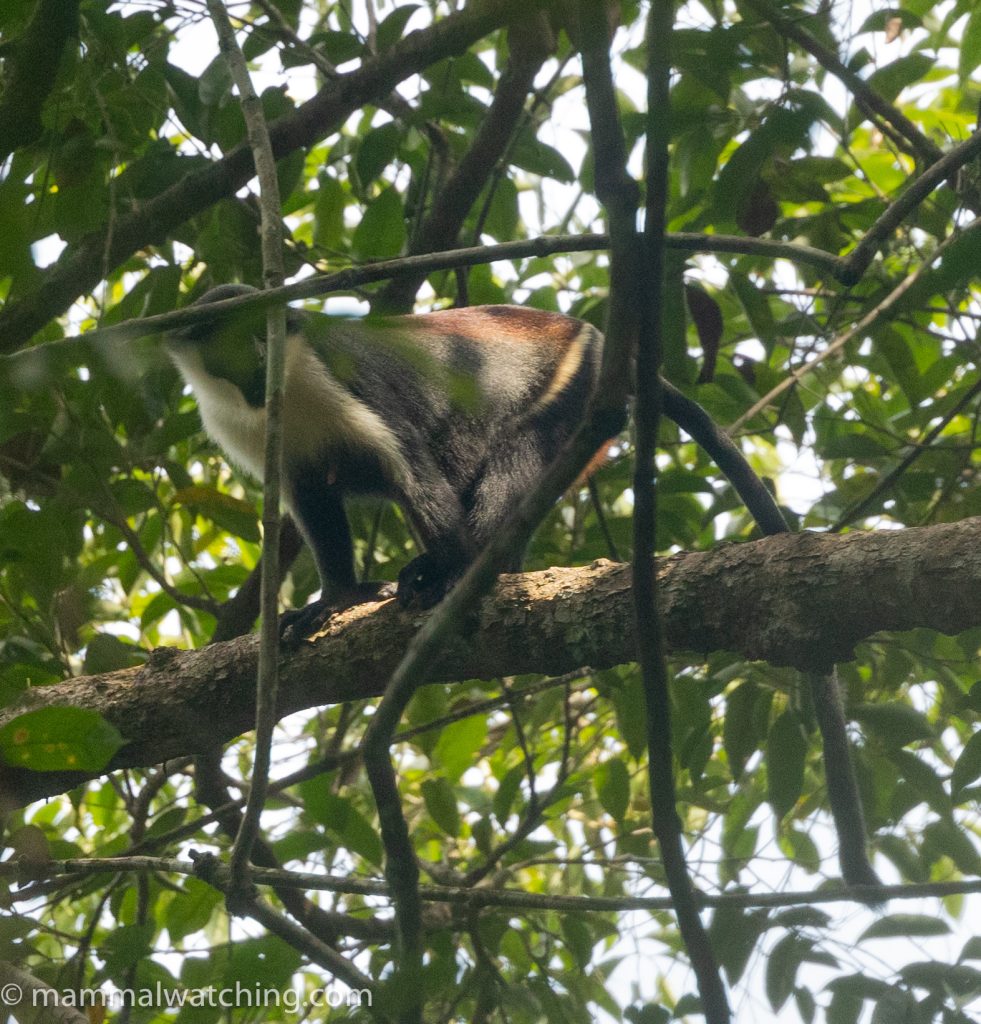
Diana Monkey (Cercopithecus diana)
One of the most commonly encountered monkeys around Camp Chimpanzee. Seen daily.
Spot-nosed Monkey (C. petaurista)
Common around Ecotel Touraco and Camp Chimpanzee. Seen daily.
King Colobus (Colobus polykomos)
Common around Ecotel Touraco and Camp Chimpanzee. Seen daily.
Upper Guinea Red Colobus (Piliocolobus badius)
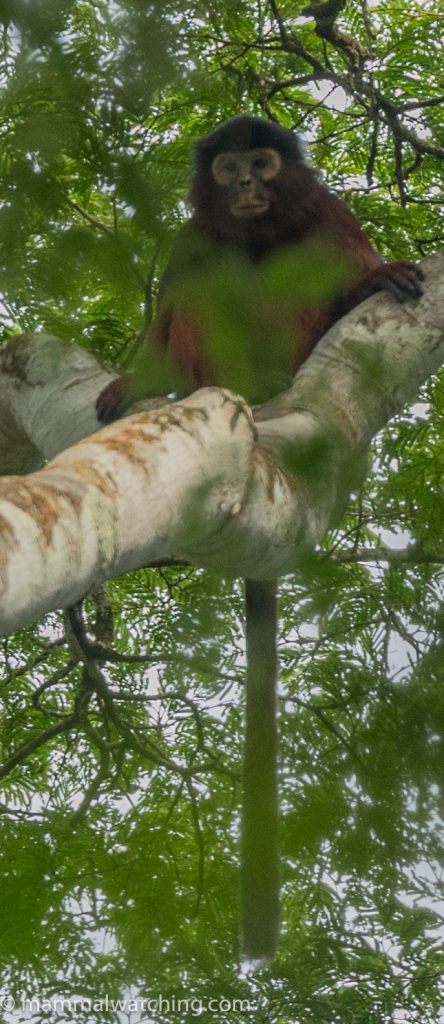
Upper Guinea Red Colobus (Piliocolobus badius)
Seen every other day around Camp Chimpanzee.
Chimpanzee (Pan troglodytes)
Heard several times and seen twice near Camp Chimpanzee. Camp Chimpanzee can arrange chimp tracking early each morning with the habituated troop of tool-using chimps. This sounds like fun and had we run out of duikers to look for we would have done this.
Demidoff’s Dwarf Galago (Galagoides demidoff)
We saw and heard galagos every night at both Camp Chimpanzee and Ecotel Touraco, though our IDs were often tentative and generally based on how high each animal was in a tree. Animals lower down were tentatively identified as Demidorff’s.
Thomas’s Dwarf Galago (G. thomasi)
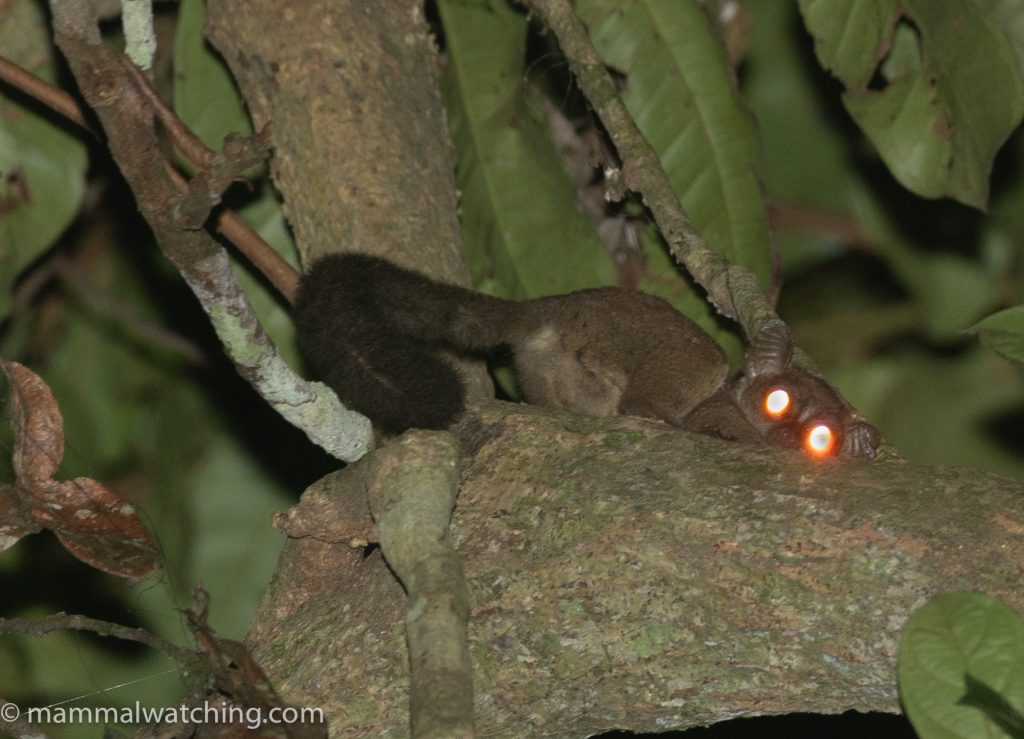
Thomas’s Dwarf Galago (Galagoides thomasi)
We saw and heard galagos every night at both Camp Chimpanzee and Ecotel Touraco, though our IDs were often tentative and generally based on how high each animal was in a tree. Animals higher up in the trees tentatively identified as Thomas’s, including this one which put on a peformance when it realised it was sharing a tree with a Green Bush Viper.
West African Potto (Perodicticus potto)
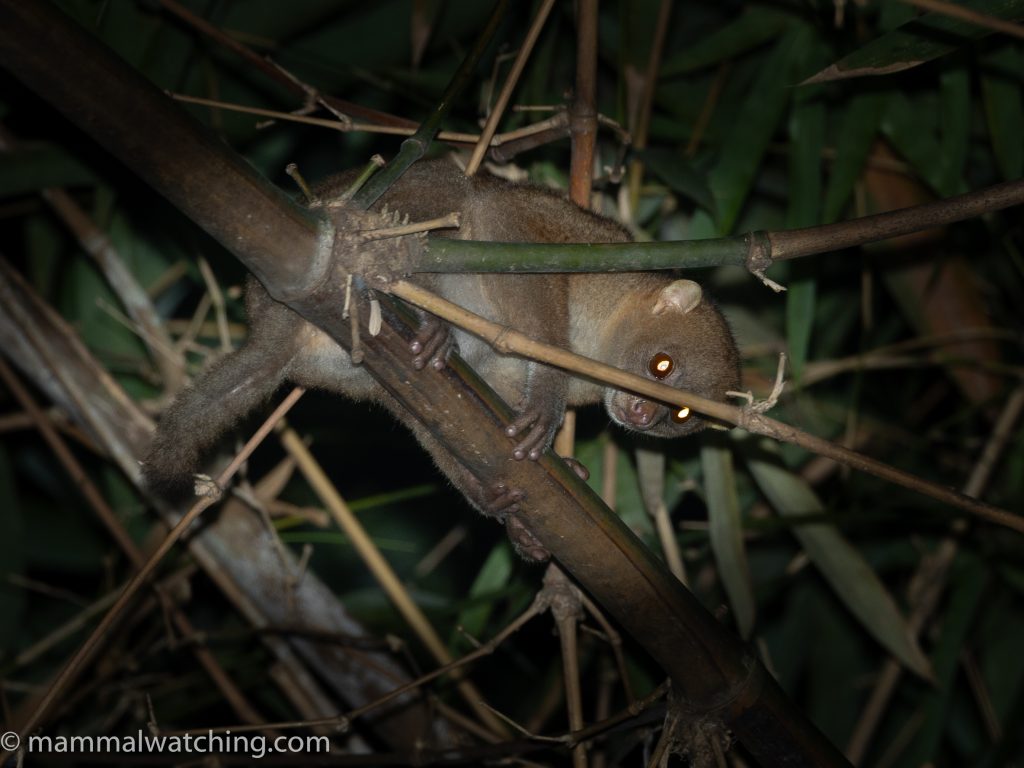
West African Potto (Perodicticus potto)
Just one pair on our last night in the stands of bamboo next to Ecotel Touraco.
African Brush-tailed Porcupine (Atherurus africanus) – lifer
We were told a porcupine was visiting the compost heap at Camp Chimpanzee every night. I waited all week in vain to be summoned when it was spotted, so on the last night I made a more concerted effort. Kevin took us to some fallen trees about 15 minutes uphill from camp where he guaranteed we would see one of the porcupines that lived inside them. We waited an hour. No porcupine. It was now after midnight. Back at camp I visited the compost heap and within 5 minutes saw a beautiful Brush-tailed Porcupine eating what was left of my dinner. I didn’t manage to get a photograph but the animal was larger and more brightly coloured than I had imagined. I went to find Charles and we waited another 45 minutes for the animal to return but it didn’t, though we saw several rats running around so we should have spent more time there.
Nagtglas’s African Dormouse (Graphiurus nagtglasii)
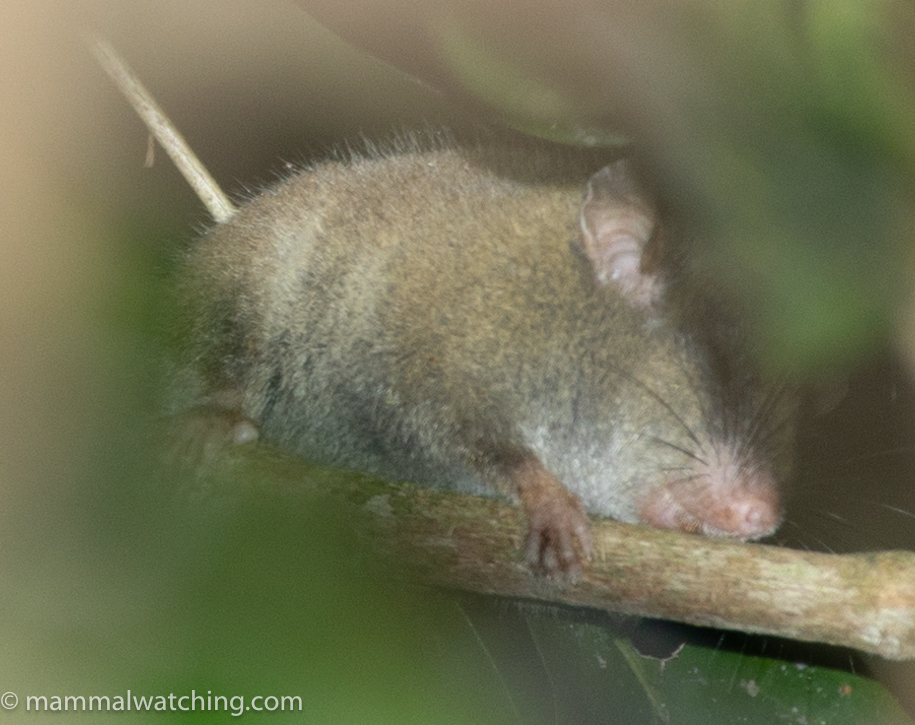
Nagtglas’s African Dormouse (Graphiurus nagtglasii)
We saw just one graphiurus at night near Camp Chimpanzee. Venkat believed this animal was too robust to be any species other than Nagtglas’s.
Fire-footed Rope Squirrel (Funisciurus pyrropus)
One seen briefly running along the forest floor and into a hollow tree near Camp Chimpanzee.
Red-legged Sun Squirrel (Heliosciurus rufobrachium)
One or two seen briefly around Camp Chimpanzee including one in the campground.
Forest Giant Squirrel (Protoxerus stangeri)
One seen well in the mid-afternoon near Camp Chimpanzee.
Lord Derby’s Anomalure (Anomalurus derbianus)
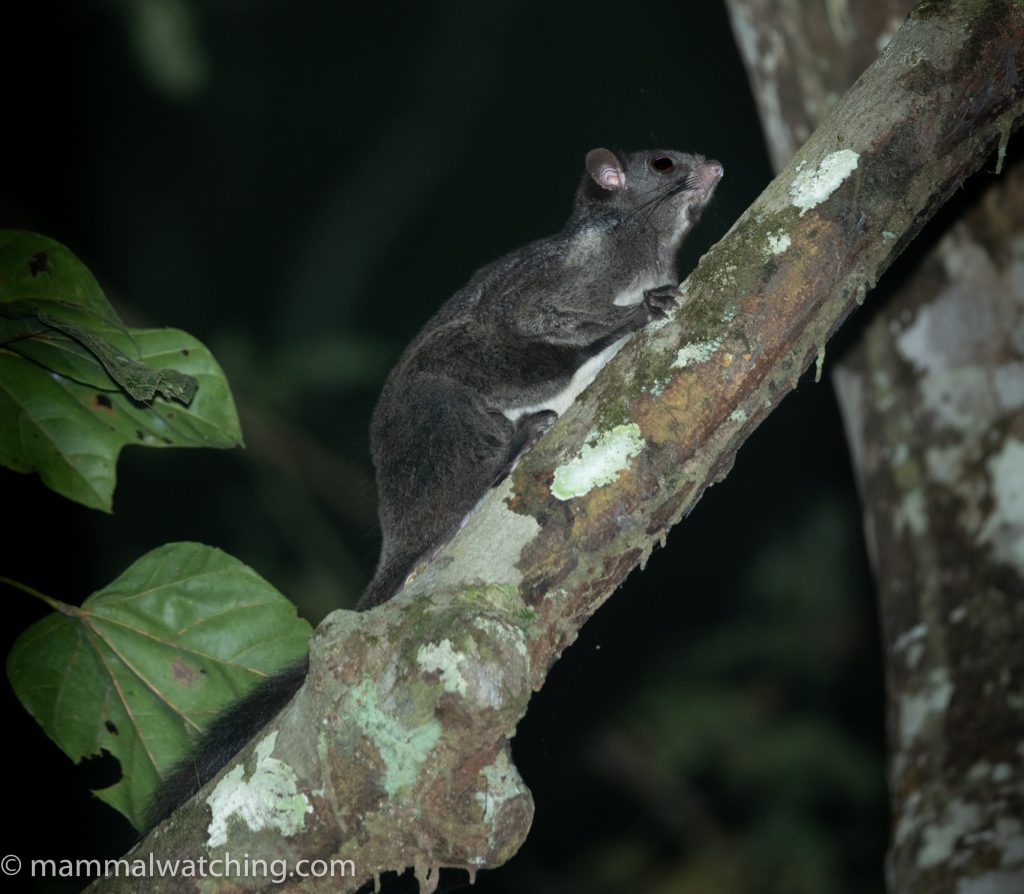
Lord Derby’s Anomalure (Anomalurus derbianus)
Two animals on different nights near Camp Chimpanzee. As Ben noted the subspecies is quite dark here and could easily be confused with Pel’s Anomalure.
Lesser Anomalure (A. pusillus) – lifer
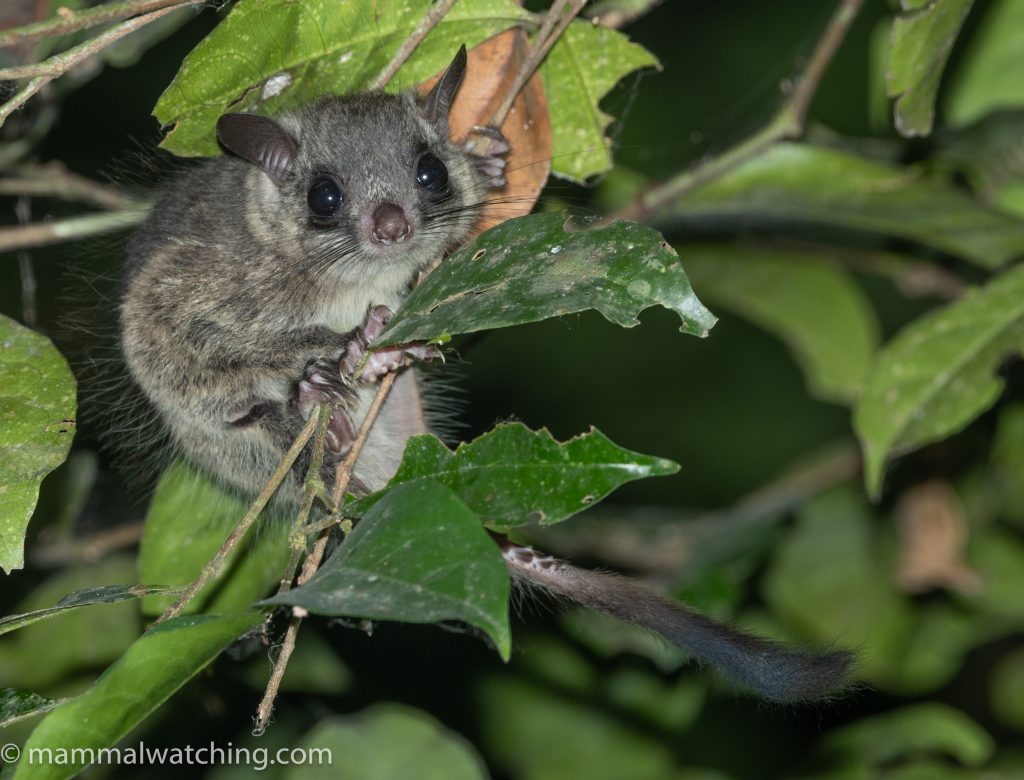
Lesser Anomalure (Anomalurus pusillus)
A key target for me and we had a great look at what appears to be a young animal shortly after dusk on our way back to Camp Chimpanzee from a duiker stakeout. It was only a few metres above us, perched at the end of a branch, and may just have emerged from a tree hollow close by. Lesser Anomalures are smaller than I had realised: I’d estimate this one had a head-body length not more than 15cm.
Common Defua Rat (Dephomys defua) – lifer
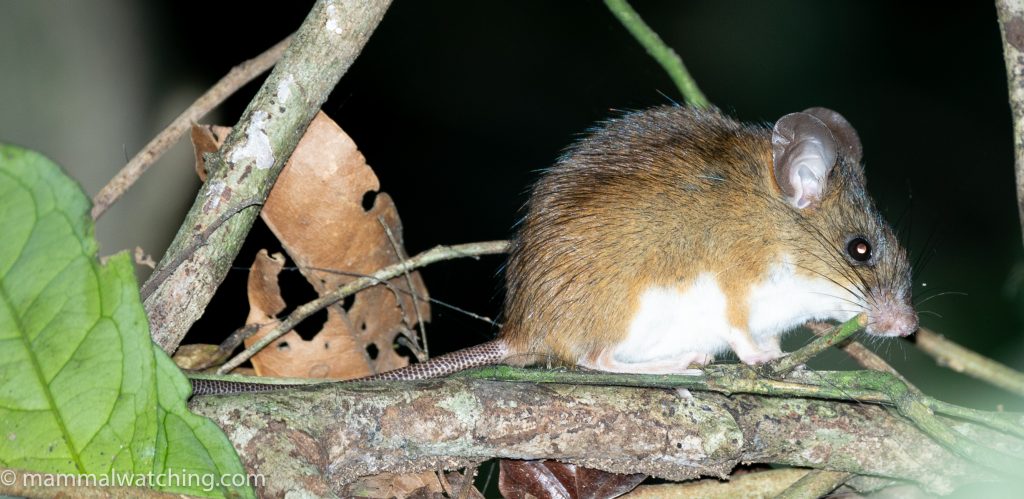
Common Defua Rat (Dephomys defua)
Seen most nights in trees at both Camp Chimpanzee and Ecotel Touraco. A robust mouse with a very long tail and distinctive dark long bristles over the rump.
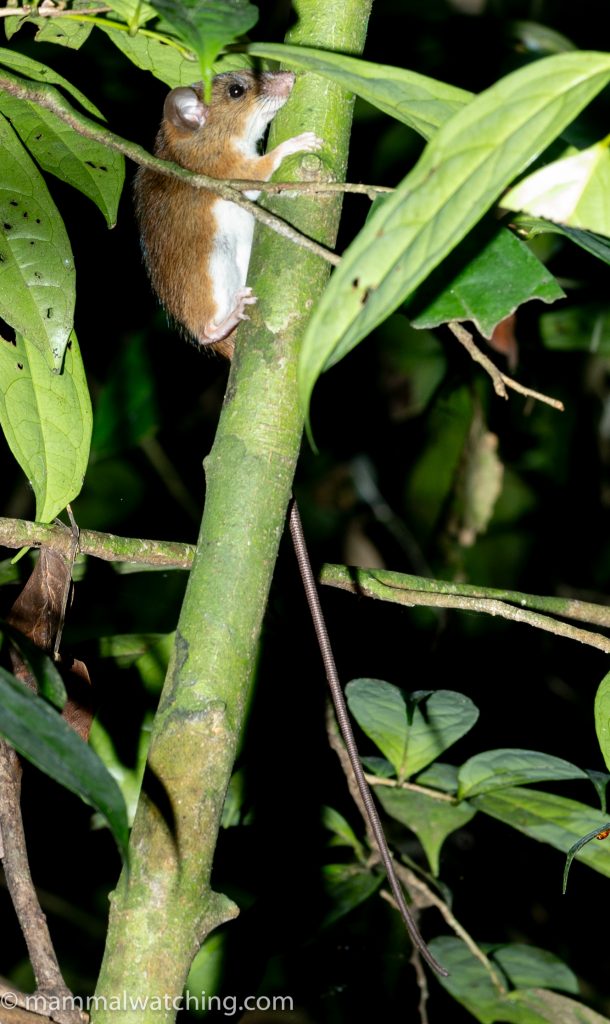
Common Defua Rat (Dephomys defua)
Edwards’s Swamp Rat (Malacomys cf. edwardsi) – lifer
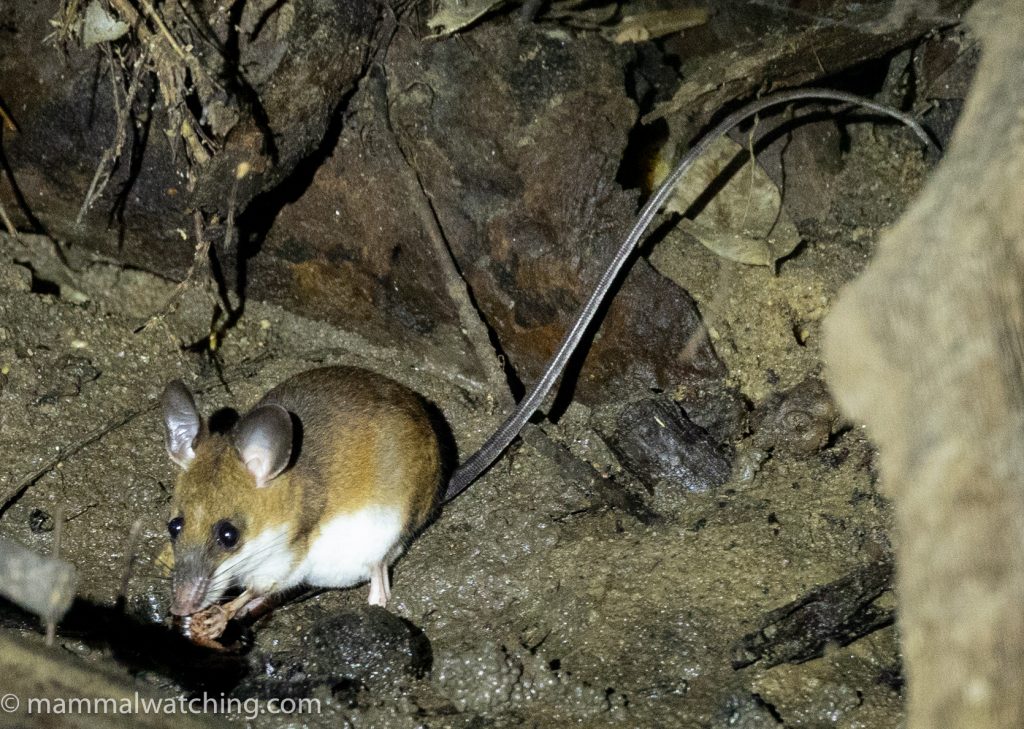
Edwards’s Swamp Rat (Malacomys cf. edwardsi)
We had several of these distinctive, long-legged rats at night near Camp Chimpanzee. Two malacomys species have been recorded in the park and they are apparently impossible to differentiate unless they are in the hand. A 2010 small mammal survey found that Malacomys edwardsi outnumbered M. cansdalei by about 10:1. So it seems likely most, if not all, the animals we saw were Edward’s Swamp Rats. But we do not know for sure.
West African Wood Mouse (Hylomyscus simus) – lifer
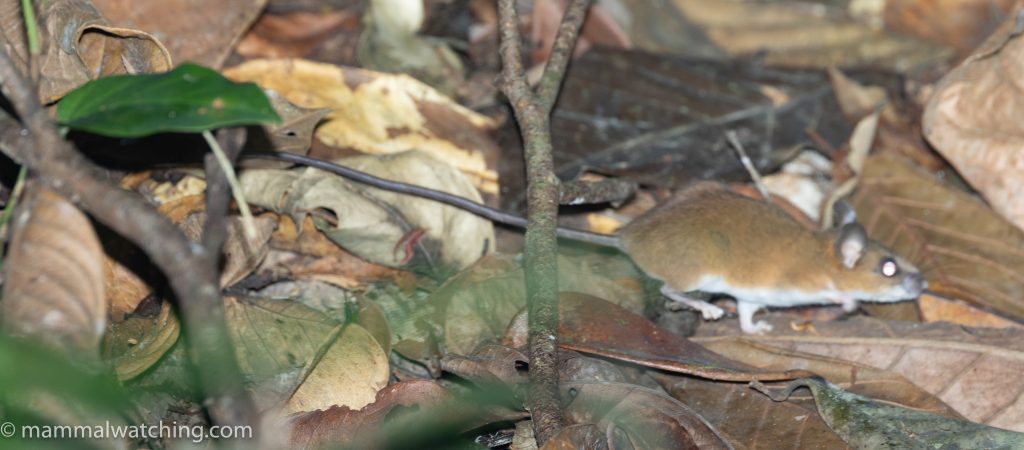
West African Wood Mouse (Hylomyscus simus)
One seen well at night near Camp Chimpanzee. This is the only hylomyscus species recorded in a 2010 small mammal survey in Tai.
West African Soft-furred Mouse (Praomys rostratus) – lifer
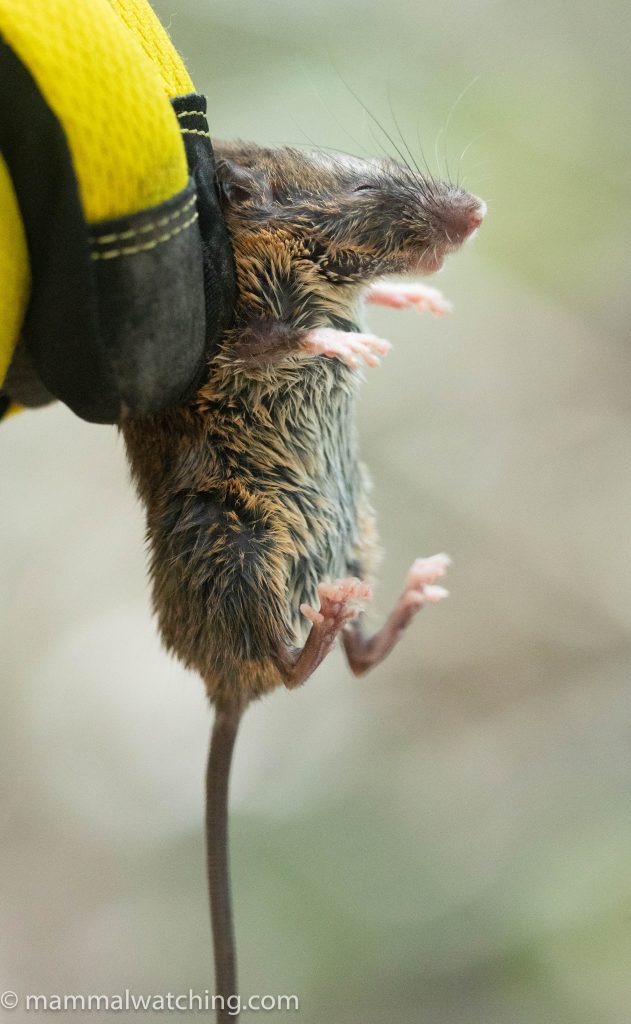
West African Soft-furred Mouse (Praomys rostratus)
One caught near Camp Chimpanzee in a tree. This is the only praomys species recorded in a 2010 small mammal survey in Tai.
Forest Giant Pouched Rat (Cricetomys emini)
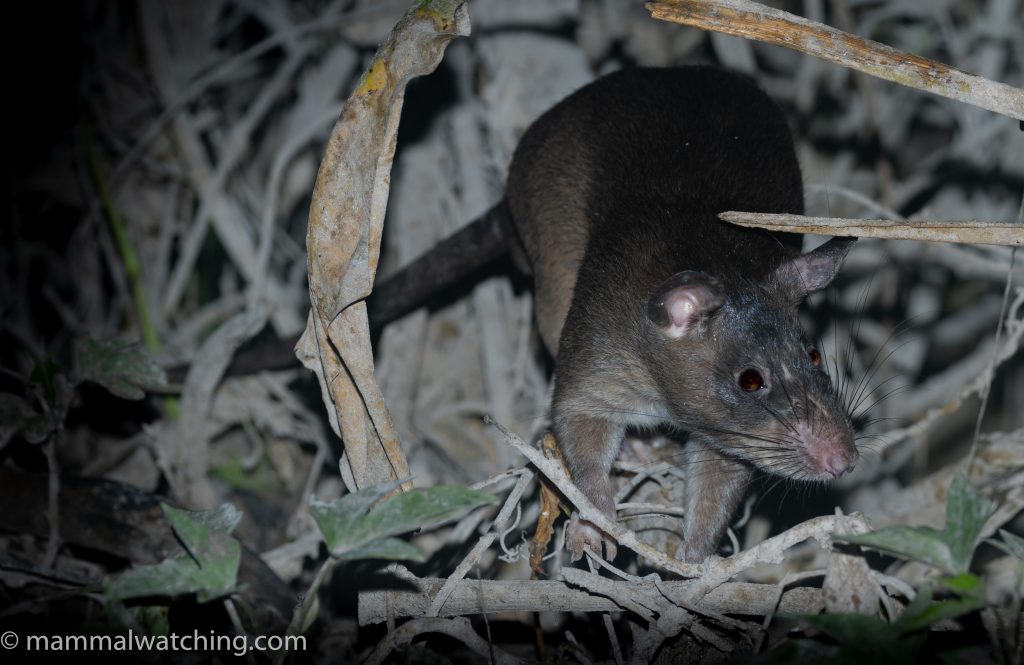
Forest Giant Pouched Rat (Cricetomys emini)
Three or more seen at night around Camp Chimpanzee including this animal raiding the compost heap in camp.
Büttikofer’s Epauletted Fruit Bat (Epomops buettikoferi)
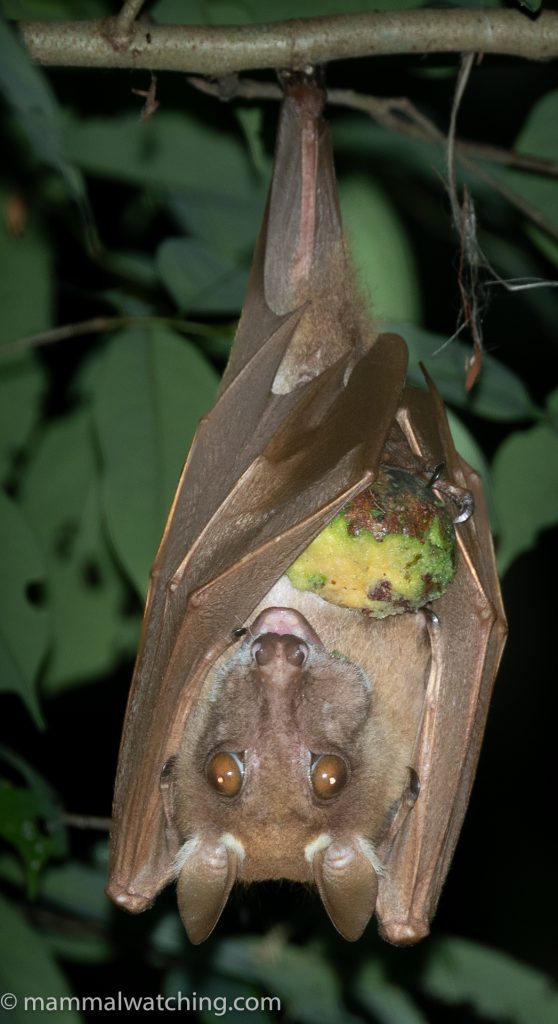
Büttikofer’s Epauletted Fruit Bat (Epomops buettikoferi)
One perched at night near Ecotel Touraco. The ID was confirmed by Afribats.
Hammer-headed Fruit Bat (Hypsignathus monstrosus) (heard)
Heard, but not seen, at night near Camp Chimpanzee.
Halcyon Horseshoe Bat (Rhinolophus alcyone) – lifer
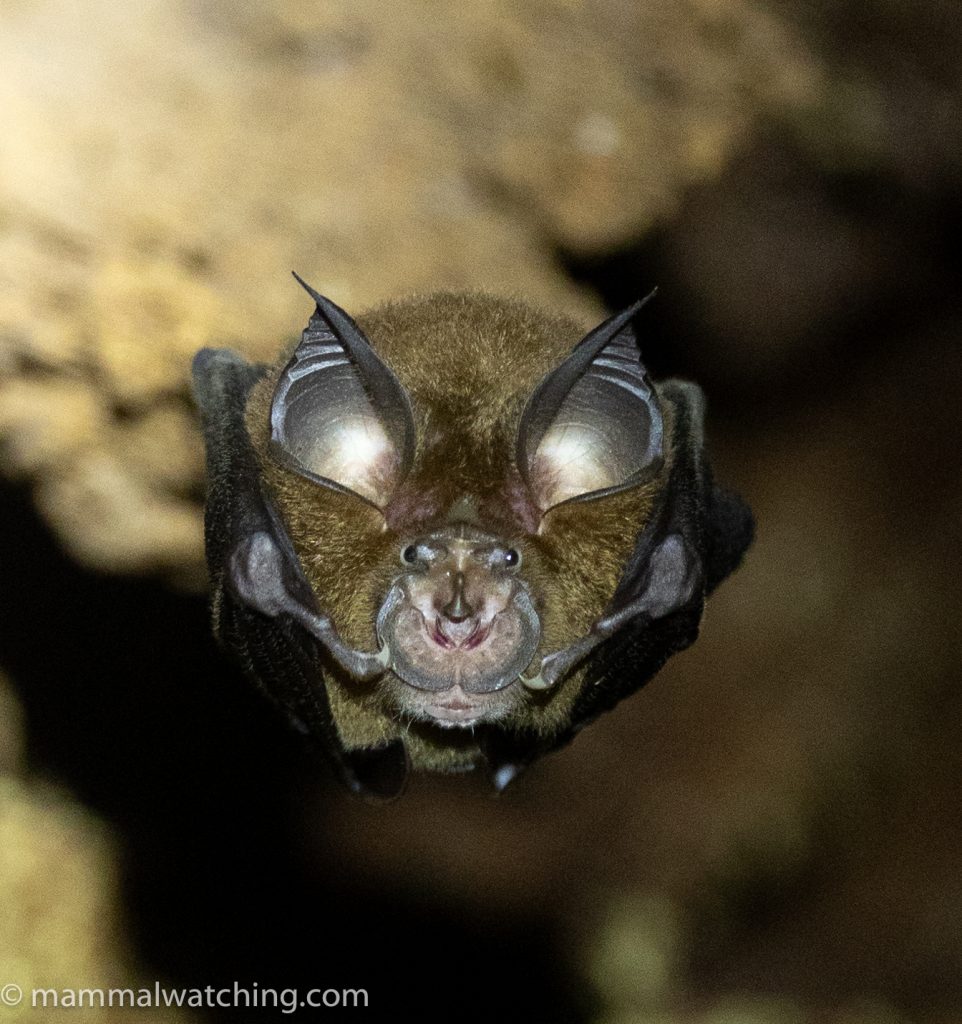
Halcyon Horseshoe Bat (Rhinolophus alcyone)
A single animal roosting high inside a hollow tree near Camp Chimpanzee. Identified to species level by Afribats.
Slit-faced Bat species (Nycteris sp,)
A single bat perched at night near Camp Chimpanzee. It flew before we could get decent photographs.
Common African Pangolin (Phataginus tricuspis) – lifer
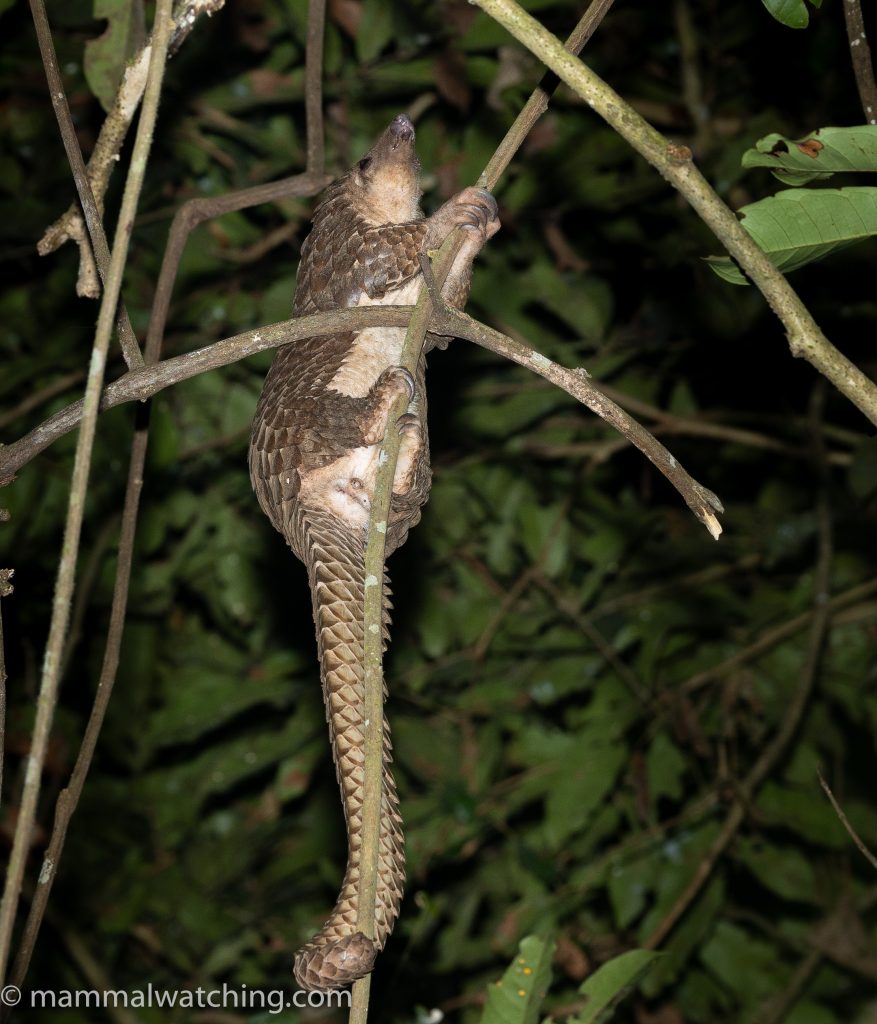
Common African Pangolin (Phataginus tricuspis)
One seen about midnight near Camp Chimpanzee. There are three pangolin species in the park and Kevin said this one is not particularly uncommon, though it was unusual to see one as relaxed. We disturbed this animal on the ground as we were walking along a trail. It climbed a small tree to the side of the trail and sat a few metres above the ground for 20 minutes, apparently unconcerned by us.
Liberian Mongoose (Liberiictis kuhni) – lifer
The mammal of the trip. We had been staking out the zebra duiker location (see above) for 3 hours. Not long after dark Charles spotted an animal moving along the dry stream bed in front of us through his thermal. When we saw the animal more clearly in our scopes we thought it might be a genet but even through the thermal scope the tail looked too bushy and tapered. I squeaked as softly as I could and the animal started walking then bounding towards us. When I lit it up with my flashlight it was only 3 metres away. Kevin and I both exclaimed “Liberian Mongoose!”. It was unmistakable: its exaggerated snout clearly distinguished the animal from the other mongooses in the area. As soon as I put the light on the beast it turned and fled, so no chance of a picture during our brief encounter. We made a video shortly afterwards to capture the moment.
Although the species had not really been on my radar, it was only after I saw Kevin’s reaction that I realised how rare this animal is. He has worked in the park for 18 years, leading tourists and chimpanzee researchers along the trails. This was only his second encounter with a Liberian Mongoose. The other – in 2018 – was equally brief but more distant. He said – I think – that he saw that animal in the mid afternoon after it was disturbed by chimps. Back in Abidjan I read more about the species and this paper is a nice summary: first discovered in the late 1950s from skulls, it took 30 years to capture a live animal.
I was also surprised, given Kevin’s reaction, to see that it was reportedly seen three times in 2022 according to reports on mammalwatching. I dug into these sightings a bit more and none seem certain: in each case the ID was made after a brief sighting and /or after trying to rule other species out. Indeed, Kevin was there for one of them and was not convinced he had seen a Liberian Mongoose. So given the principle that “extraordinary mammals require extraordinary evidence” they might be better treated as possible sightings. We plan to write up our sighting for the IUCN.
Johnston’s Genet (Genetta johnstoni) – lifer
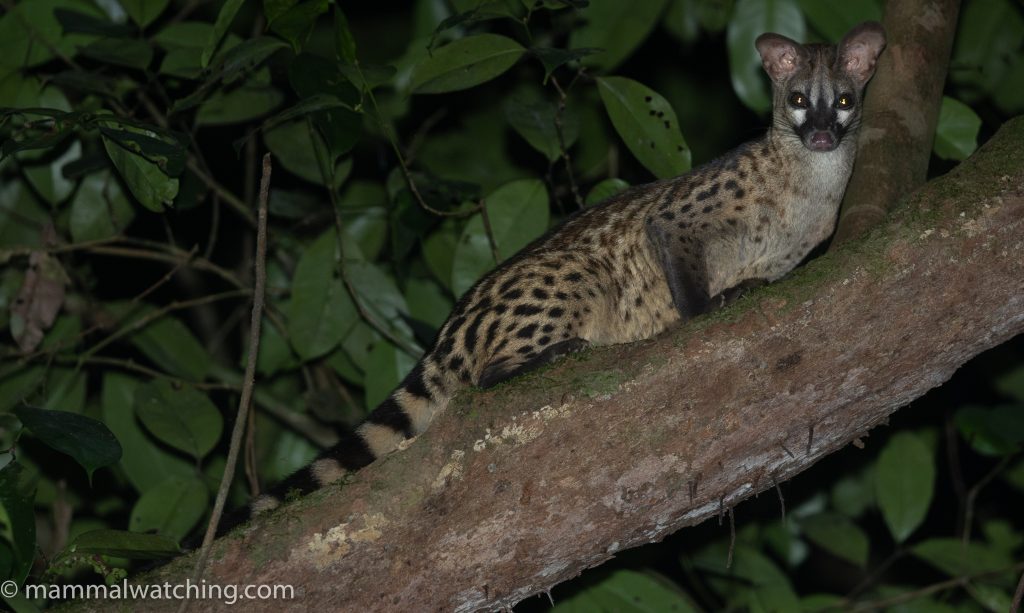
Johnston’s Genet (Genetta johnstoni)
We saw five genets and photographed them with varying degrees of success. Charles, Kevin and I were convinced we had two, possibly three species. But when we shared the photographs with Philippe Gaubert, who knows more about the genets in West Africa than anyone, he confirmed that all 5 animals were Johnston’s Genets. According to Wikipedia this species was known only from museum collections until 2000 when a dead animal was found in Tai, with a live animal caught there a few months later. But as genets can be notoriously hard to ID then perhaps this is not so surprising. There seems to be at least one other species in the park: Ben Schweinhart photographed two animals in Tai that Philippe identified as Pardine Genets. It is possible that Bourlon’s Genet also occurs there.
Brooke’s Duiker (Cephalophorus brookei) – lifer
I saw one well, from the boat, along the riverbank near Ecotel Touraco. We saw another in the forest at night near Camp Chimpanzee.
Banded Duiker (Cephalophula zebra) (Kevin only)
Kevin had a good look at an animal near Camp Chimpanzee that both Charles and I managed to miss! I don’t want to talk about it again. (See the section above on duikers).
Maxwell’s Duiker (Philantomba maxwellii)
We saw at least ten animals around Camp Chimpanzee. Several at night and several during the day during our duiker stakeouts.
Northern Bushbuck (Tragelaphus scriptus) (heard)
We hear a large animal moving through vegetation in the late afternoon next to the dining area at Ecotel Touraco. And we saw the vegetation moving. Kevin and Charles were sure it was not a duiker and Kevin thought it was most likely a Northern Bushbuck. He had seen one earlier that day.
Water Chevrotain (Hyemoschus aquaticus)
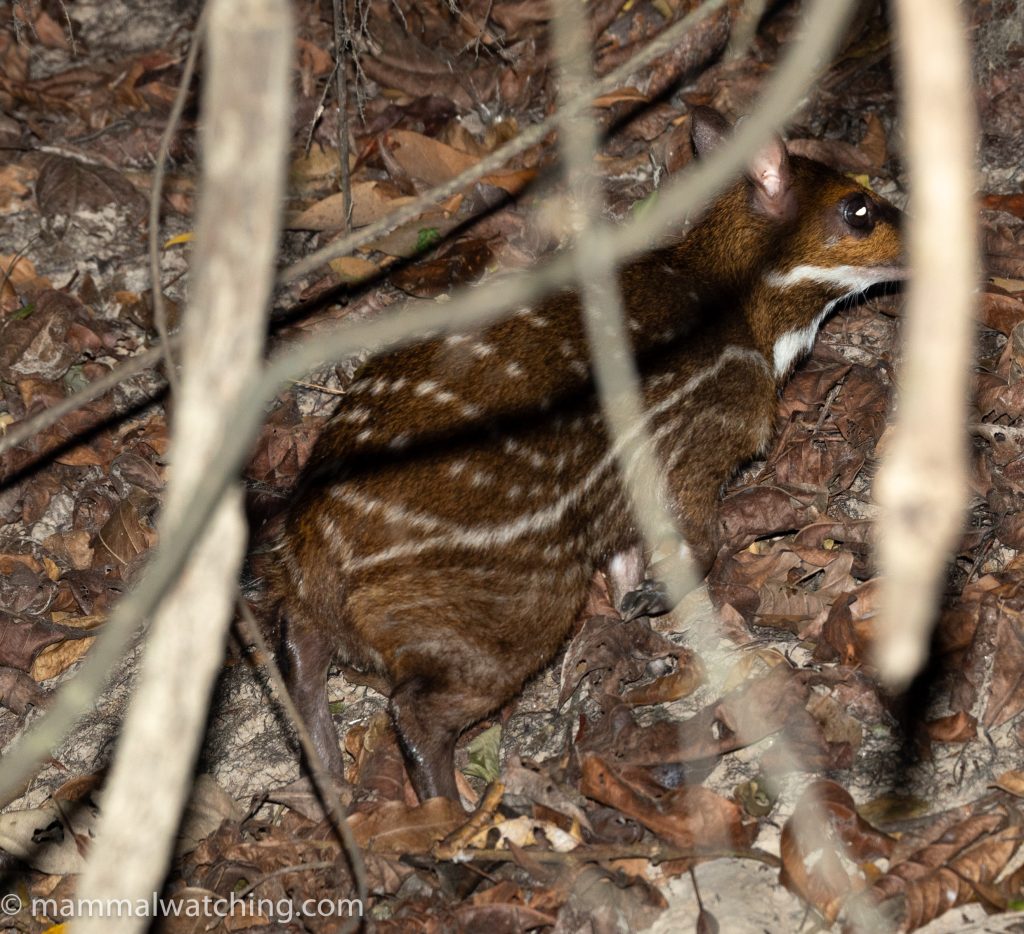
Water Chevrotain (Hyemoschus aquaticus)
One along the riverbank near Ecotel Touraco, seen well from the boat on our first evening.
32 species including 11 lifers for me.
Stuff We Missed
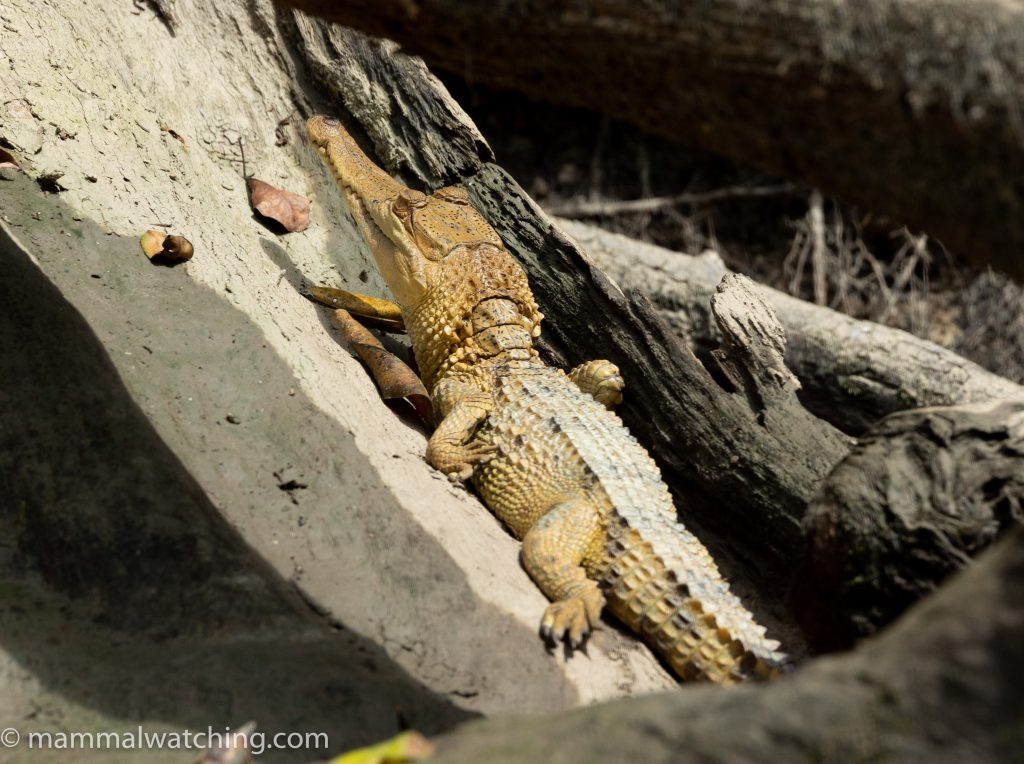
West African Slender-snouted Crocodile
We missed plenty of species, many of which we didn’t make any special effort to see. Evidence of Pygmy Hippos was all along the river and we saw very fresh scat and tracks a couple of times in the forest close to Camp Chimpanzee. Kevin thought the species may have become a little more common in recent years, even if duiker numbers were continuing to decline. Bongos are rare and very rarely encountered though we saw recent camera trap images of animals taken in the middle of the night. We also saw fresh Elephant tracks along the river.
Although Giant Pangolins are rarely seen, Kevin said they are possible to see when he finds an active burrow. Burrows remain occupied for several months and the species generally emerges after midnight he said (correction I think he said). Black-bellied Pangolins seem a little easier to see in other parts of the forest rather than close to Camp Chimpanzee. I had hoped to see a Pel’s Anomalure but they seem rare around Camp Chimpanzee (and easy to confuse with the quite dark Lord Derby’s Anomalures here). Golden Cats seem as rare and secretive here as everywhere else: Kevin may have seen one once.
Among the duikers, which we did make an effort to see, Bay Duiker are less uncommon than the other species we missed. I didn’t get much of a feel for how often they see Black Duiker, but Zebra and Jentink’s Duikers are rarely encountered, and even more rarely seen well. Jentink’s Duiker in particular seem very wary: Kevin said you were very unlikely to get more than a fleeting glimpse of a bolting animal if you are lucky enough to get that close. All the duikers seem subject to hunting pressure still and we heard gunshots once or twice.
There is lots to return for.
Thank you
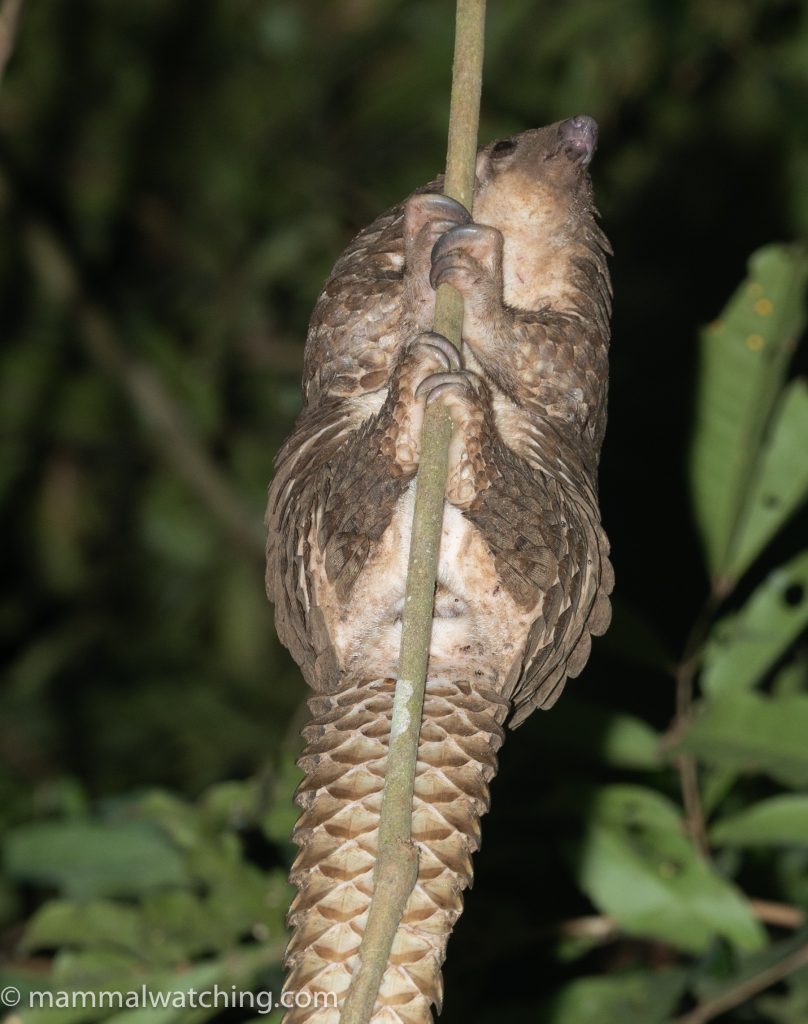
Common African Pangolin (Phataginus tricuspis)
Thank you to Ben Schweinhart for his excellent detailed report and Ian Thompson for his report which was also helpful. Thank you also to Tom Clode for his advice on how to book the trip and to Venkat Sankar, Afribats and Phillipe Gaubert for helping to identify the smaller rodents, bats and genets we photographed. A big thank you to Karl and his efficient team at Tai Forest Lodges, and to the friendly staff at Ecotel Touraco and Camp Chimpanzee. Thank you of course to Charles Foley for his company, humour and for joining me in torturing the French language to near breaking point. Most of all a massive thanks to Kevin Hino, our outstanding guide, who is now firmly enshrined in my mammalwatching hall of fame.
Post author


Leave a Reply
You must be logged in to post a comment.